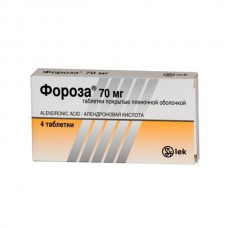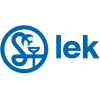Expiration date: 10/2025
The composition and form of issue:
Tablets, film-coated. 1 tablet contains active substance
sodium alendronate trihydrate 91,35 mg
(equivalent to 70 mg of alendronova acid)
other ingredients: microcrystalline cellulose silicon dioxide colloidal anhydrous croscarmellose sodium magnesium stearate
shell: Lustre Clear LC103 (MCC, carrageenan, macrogol 8000)
in blister packs of 2 or 4 PCs the paper cartons 1, 2, 3, 4, or 6 blisters.
Description pharmaceutical form:
White, round, biconvex tablets, film-coated, engraved on one side "ALN 70".
Pharmacokinetics:
Absorption. The bioavailability of alendronate in a dose 70 mg when administered on an empty stomach 2 hours before a standard Breakfast, were women of 0.64%, in men and 0.59%. When you receive a 1 hour or half an hour before Breakfast the bioavailability of alendronate was decreased to 0.46 and 0.39%, respectively. In clinical studies confirmed the effectiveness of alendronate in the application at least 30 min before the first meal or drinks.
The bioavailability of alendronate is insignificant when it is administered with food or within 2 hours after a meal. When co-administered with coffee or orange juice the bioavailability of the drug is reduced by approximately 60%.
Distribution. Alendronate after an intravenous dose of 1 mg/kg temporarily distributed in soft tissues and then rapidly redistributed to bone or excreted in the urine. Average Vd, not including the bone, is a human of about 28 L. the concentration of the drug in plasma is negligible (less 5 ng/ml). The plasma protein binding is about 78%.
Metabolism. There is no evidence that alendronate metabolized in the human body.
Excretion. After a single intravenous administration of alendronate labelled carbon atoms of [14C] within 72 h by the kidneys is about 50% substance and a minor amount of through the bowel. After a single intravenous injection of 10 mg of alendronate its renal clearance is 71 ml/min, and systemic clearance does not exceed 200 ml/min.
The concentration of plasma 6 h after intravenous management is reduced by more than 95%.
Description pharmacological action:
Non-hormonal specific inhibitor osteoclastic bone resorption inhibitory activity of osteoclasts. Stimulates bone formation, restores a positive balance between resorption and rebuilding of bone, increases bone mineral density (regulates calcium and phosphorus metabolism), promotes formation of bone tissue with normal histological structure.
Indications:
- treatment of osteoporosis in postmenopausal women, including to reduce the risk of spinal compression fractures and femoral neck fractures
- treatment of osteoporosis in men to prevent fractures
- treatment of osteoporosis caused by prolonged use of corticosteroids drugs.
Contraindications:
- hypersensitivity to alendronate or other components of the drug
- stricture or achalasia of the oesophagus and other conditions leading to slower movement of food through the esophagus
- the inability of the patient to stand or sit for 30 min.
- hypocalcemia
- severe renal insufficiency (Cl creatinine less than 35 ml/min)
- severe disorders of mineral metabolism
- pregnancy
- lactation
- children's age (the efficacy and safety not established).
Caution: patients with diseases of the gastrointestinal tract, such as dysphagia, gastritis, duodenitis, peptic ulcer in the acute stage, active gastrointestinal bleeding or surgery on the upper gastrointestinal divisions in history, hypovitaminosis D.
Side effects:
Gastrointestinal: abdominal pain, diarrhoea disorders (constipation or diarrhoea, flatulence, nausea, vomiting), dysphagia, heartburn, oesophagitis, dystonia of the stomach, ulceration of the mucous membrane of the mouth, throat, esophagus, stomach and duodenum, melena.
From the nervous system: headaches, irritability.
Allergic reactions: hypersensitivity reactions (including flushing of the skin, hives, angioneurotic edema).
Other: pain in the bones, muscles and joints, photosensitivity, uveitis, scleritis, transient asymptomatic hypocalcemia and hypophosphatemia, in the treatment of bifosfonatami rarely observed osteonecrosis of the jaw.
Drug interactions:
Concurrent use of calcium (including food supplements) and antacids reduces the absorption of alendronate. In this regard, it is recommended to take other drugs not earlier than 30 min after ingestion of Foroz.
NSAIDs (including acetylsalicylic acid) may increase the side effects of alendronova acid from the blood. Despite the fact that specific studies on drug interactions have been assessed, the use of alendronate in clinical studies with a large number of widely used drugs have not been accompanied by the development of clinically significant interactions.
Method of application and dose:
Inside.
Tablet Foroz should be taken in the morning, no later than 30 minutes before the first food, beverage or other drug with a full glass of plain water (at least 200 ml). Tablets cannot be chewed. You should not take a horizontal body position at least for 30 minutes after taking the drug. Do not take the drug at bedtime or before the morning rising from bed. The recommended dose is 70 mg (1 table.) once a week.
For elderly patients and patients with moderate impairment of renal function (Cl creatinine more than 35 ml/min) dose adjustment is not required.
Overdose:
Symptoms: abdominal pain, dyspeptic disorders, dysphagia, heartburn, esophagitis, gastritis may develop hypocalcemia and hypophosphatemia.
Treatment: symptomatic. Shows the use of milk and antacids to bind alendronate. In connection with the risk of esophageal lesions should not induce vomiting, the patient should be kept in a vertical position.
Special instructions:
The pills of Foroz should be only plain water, because other drinks (including mineral water, tea, coffee, fruit juices) impair the absorption of the drug. Receiving alendronate at bedtime or in a horizontal position increases the risk of developing esophagitis. Before therapy with a medication Foroz necessary correction of hypocalcemia and other disorders of metabolism (such as vitamin D deficiency). In connection with the increase in the therapy with alendronate mineral density of bone tissue there may be a small clinically asymptomatic decrease in the levels of calcium and phosphate in serum, especially in patients receiving corticosteroids, in whom calcium absorption may be reduced. Therefore, the supply of sufficient amounts of calcium and vitamin D in the body is especially important in patients receiving corticosteroids. Patients should be warned that accidental omission of the drug in the dosage 1 time a week they should take 1 tab. in the morning, the nearest day (it is unacceptable to take 2 table. on the same day). Should continue to take 1 table. the day of the week, which was chosen at the beginning of therapy.
In the appointment of other bisphosphonates were rarely observed osteonecrosis of the jaw. Most cases reported in cancer patients during dental treatments, several cases of patients with postmenopausal osteoporosis or other diseases. Risk factors for development of osteonecrosis of the jaw include a diagnosis of cancer, concomitant therapy (chemotherapy, radiotherapy, corticosteroids) and other violations of the (anemia, coagulopathy, infection, gum disease). The majority of the cases observed in the on/in the appointment of bisphosphonates, but cases have been observed in patients treated with the drugs inside. Surgical dental intervention during therapy bifosfonatami may increase symptoms of osteonecrosis of the jaw. It is unknown whether it reduces the risk of osteonecrosis of the jaw bisphosphonates cancel. The decision on treatment must be taken for each patient individually after assessing the risk/benefit.



